A Private Tour today, the second of our two days. It felt really autumnal today. Storm Aileen blew in overnight, bringing heavy rain and gale force winds, gusting up to 60mph first thing this morning. Thankfully it had calmed down a little by the time we met up, the rain had stopped and there were even some brighter intervals, but the wind was still gusting up to 48mph through the morning. Undaunted, we went out to see what we could see.
Our first destination was Stiffkey Fen. On the way there, three Red Kites hung in the air over the road, enjoying the breeze. We were met by a very gusty wind when we got out of the car, but it was not so bad once we got into the shelter of the hedge along the path. A Kestrel was standing out in the middle of a recently cultivated field, presumably looking for invertebrates. Easier work than trying to hover in the wind!
As we got into the trees, we could hear Long-tailed Tits calling. A tit flock came through the wood and seemed to be making for the sunny sheltered edge along the roadside. We could just see some of the tits in the trees above us, but they were hard to see today with the movement of the branches and leaves. A couple of Chiffchaffs were calling too.
Down beside the river, we flushed a couple of Greenfinches and Chaffinches from the brambles. We could hear a Blackcap calling from the bushes too, but the birds were harder than usual to see along here, presumably they were keeping tucked well down today. The sun came out and in the shelter of the hedges a few butterflies even appeared – a couple of Red Admirals and Speckled Woods. A Green Sandpiper flew low overhead calling, presumably coming up from the Fen before continuing on its way west.
There is one spot along the path where it is possible to see over the brambles across to the Fen. We knew it was likely to be windy up on the seawall, so we stopped to look from here first. The first thing we saw was the Spoonbills. There were 12 of them at first, mostly asleep, but two were awake and walking around. A closer look revealed that it was a juvenile, one of this year’s young raised just along the coast, which was pursuing its parent begging for food. Every time the adult Spoonbill stopped, the juvenile kept pecking at its bill, so the adult kept walking. The youngster then followed behind, bobbing its head up and down. The pester power was relentless!
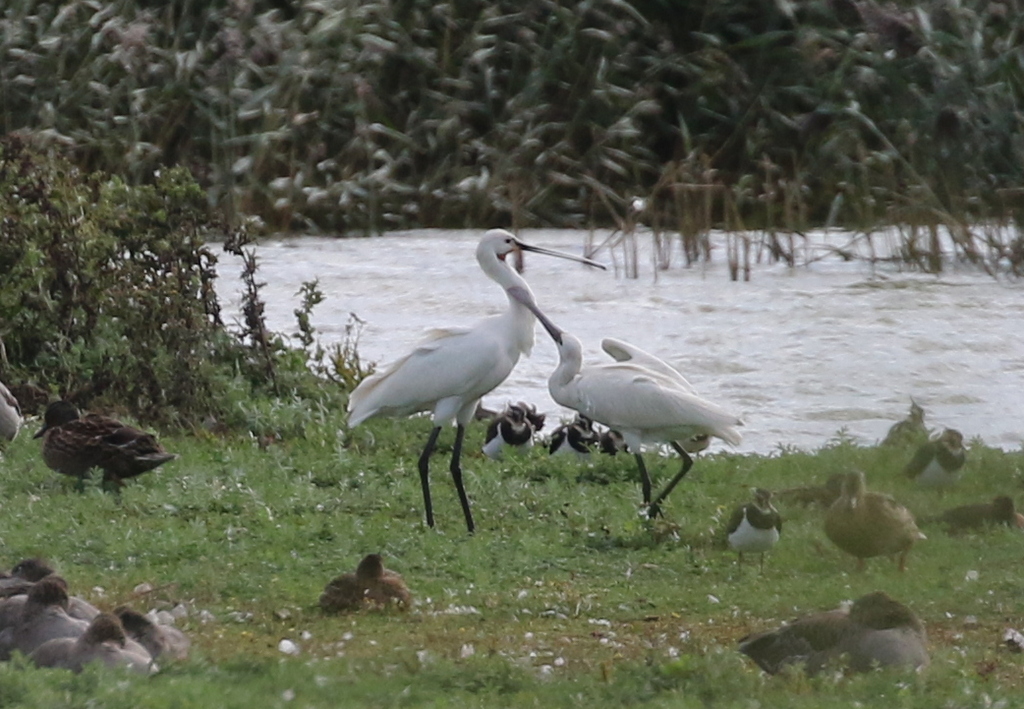 Spoonbills – this juvenile kept begging for food from its parent
Spoonbills – this juvenile kept begging for food from its parent
There were lots of geese on the Fen, mostly Greylags but a few Canada Geese too. There are more ducks on here too now, in various stages of moult. As well as all the local Mallard, there were Wigeon, Gadwall and Teal. A couple of Tufted Ducks were diving out in the middle.
After a good look from the path, we decided to brave the seawall. It was not quite as windy up here as we had feared and we had a good view out across the harbour. The tide was on its way in and the channel below the seawall was starting to fill up. Several Redshank were still feeding on the remaining mud along the edge, along with a Curlew.
There is a much better view of the Fen from up on the seawall. There were lots of waders asleep in the water just beyond the reeds, Redshank and Black-tailed Godwits. Scanning the islands, in amongst the ducks and geese, we could see several Ruff, including one with a strikingly white head. Over in their usual corner, a dozen Greenshank were already in to roost, standing in the water out of the wind. A single Redshank was with them and through the scope, we had a good comparison between the two, the Greenshank being much paler, sleeker and slightly larger too.
As the tide was rising out in the harbour, more birds flew in to roost. Another three Spoonbills came in to join the twelve already out on the Fen. More Redshank flew in from the harbour. A Greenshank took advantage of the opportunity for a quick last feed on the edge of the mud down in the harbour channel before flying up over the seawall and across to join the others.
We decided to walk round to have a look out in the harbour. On the way, a Common Buzzard was hovering out over the edge of the saltmarsh. There were not so many small birds along here today – we flushed a Meadow Pipit from the grass and a Common Whitethroat from the weeds beside the path.
The water out in the harbour was already quite high and a lot of the waders were already roosting out of view. We could still see quite a few Oystercatchers and Curlew. A small party of Turnstone, accompanied by a single Dunlin, flew in and landed on the near shore, amongst all the Herring Gulls and Great Black-backed Gulls. A single Bar-tailed Godwit flew west, before another five flew in and dropped down out of view. Out on the end of Blakeney Point, we could see a number of seals hauled out on the beach.
It was a bit exposed and breezy out on the edge of the harbour, so we started to make our way back. The Spoonbills on the Fen had multiplied in our absence, with more birds flying in from the harbour and saltmarsh ahead of the rising tide. One flew off towards Morston as we walked back, but their were still 26 now out on the Fen when we got back to count them. An adult Spoonbill was still being pursued around the island by a begging juvenile – quite possibly the two birds we had seen much earlier!
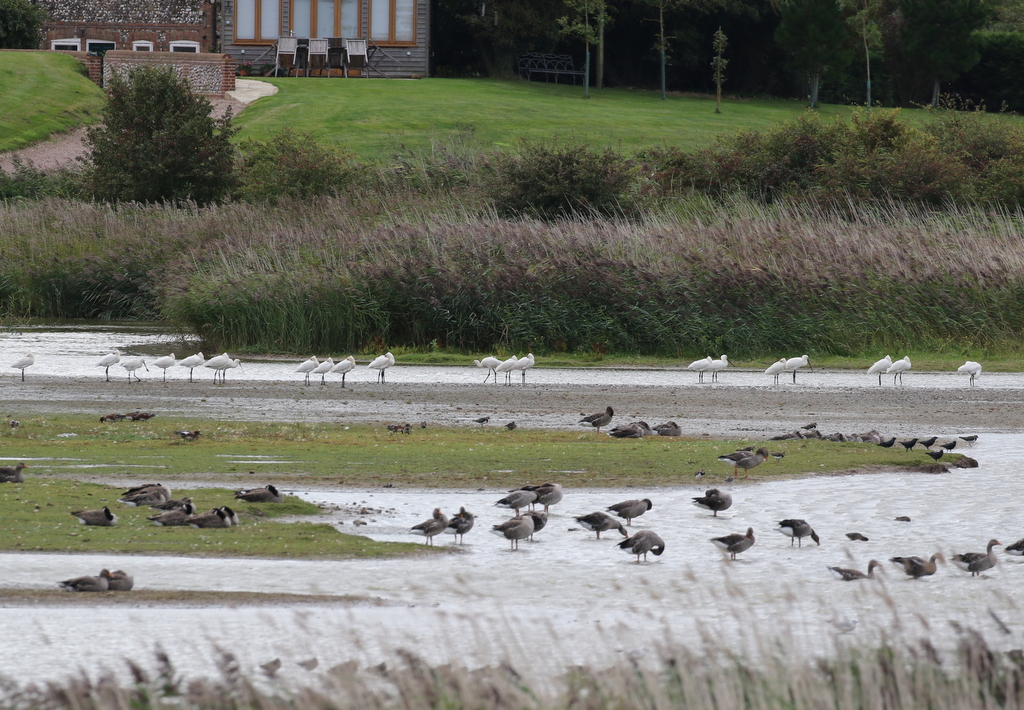 Spoonbills – most of the 26 which were on the Fen on our walk back
Spoonbills – most of the 26 which were on the Fen on our walk back
It was nice to get off the seawall and back into the shelter of the hedge beside the path. We could hear Bullfinches calling from the sallows, but couldn’t see them today. The tit flock was still feeding in the trees. When we got back to the car, we could see a flock of Lapwing out in the field next door and when we stopped to scan, we found a couple of Stock Doves here too. One of the Stock Doves was helpfully standing next to a Woodpigeon, giving us a nice side-by-side comparison through the scope.
There has been a Pectoral Sandpiper at Cley for the last few days and news had come through that it was still present this morning, so we headed round to try to see it next. We parked at the base of the East Bank and started to walk up. There were lots of martins flying low over the pools on the edge of the reedbed and skimming the bank in front of us, so we stopped to watch them. They were mostly House Martins, flashing a white rump as they banked but in with them were several plain brown backed Sand Martins too. We got some really close up views as they zoomed round us, hawking for insects.
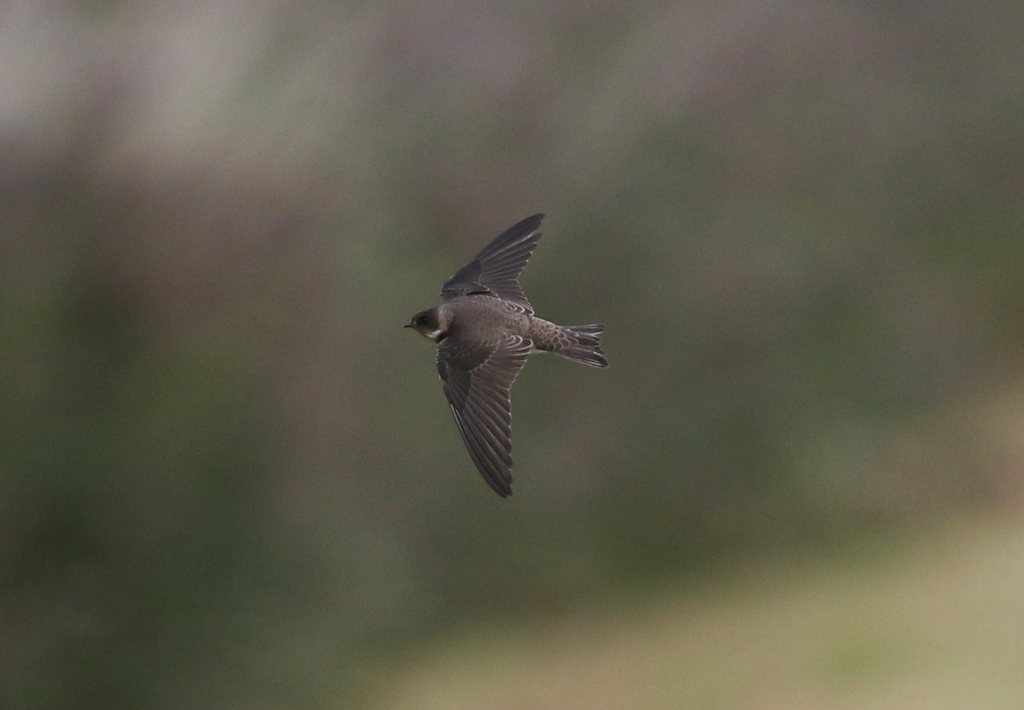 Sand Martin – hawking for insects around the East Bank
Sand Martin – hawking for insects around the East Bank
Further along the path, we could see a small group of people. We assumed they were watching the Pectoral Sandpiper, so we walked up to join them, but when we got there they pointed to the bird they were watching (which they thought was it) and it was a Ruff! There was no immediate sign of the Pectoral Sandpiper here, and we were not entirely sure whether it had actually been seen where they were looking, so we started to walk slowly on along the bank, scanning the grass and pools carefully, to see if we could refind it.
Then all the birds erupted from the grass and started to whirl round and a shout from further along alerted us to an incoming Hobby. It flew fast and low right past us, skimming over the grass, before stopping to chase something back towards the road, climbing suddenly and sharply before stooping vertically back down again. It then made for all the hirundines over the pools, which scattered, before the Hobby climbed higher and flew off over North Foreland wood.
 Hobby – flew right past us low over the grazing marsh
Hobby – flew right past us low over the grazing marsh
When the birds all settled again, there was still no sign of the Pectoral Sandpiper. There were plenty of Ruff down around the Serpentine, and lots of Black-tailed Godwits further over in the grass. As we made our way further on, we found a couple of Dunlin on the mud. At the north end of the Serpentine, an Avocet was feeding out in the water and a very pale silvery grey and white winter plumage Spotted Redshank was on the mud nearby. The Spotted Redshank waded out into the water and started feeding too, sweeping its bill rapidly from side to side, just like the juvenile we had seen at Titchwell yesterday.
There were plenty of Greylag Geese already out on the grazing marshes, but some high pitched yelping calls alerted us to another six geese flying in behind us. These were Pink-footed Geese, probably freshly arrived from Iceland for the winter. They circled over the grass but seemed to decide not to land and continued on east. A short while later they reappeared and dropped down onto the grass behind Arnold’s Marsh. Here we could get the Pink-footed Geese in the scope, noting their small size relative to the Greylags, their dark heads and dark pink-banded bills.
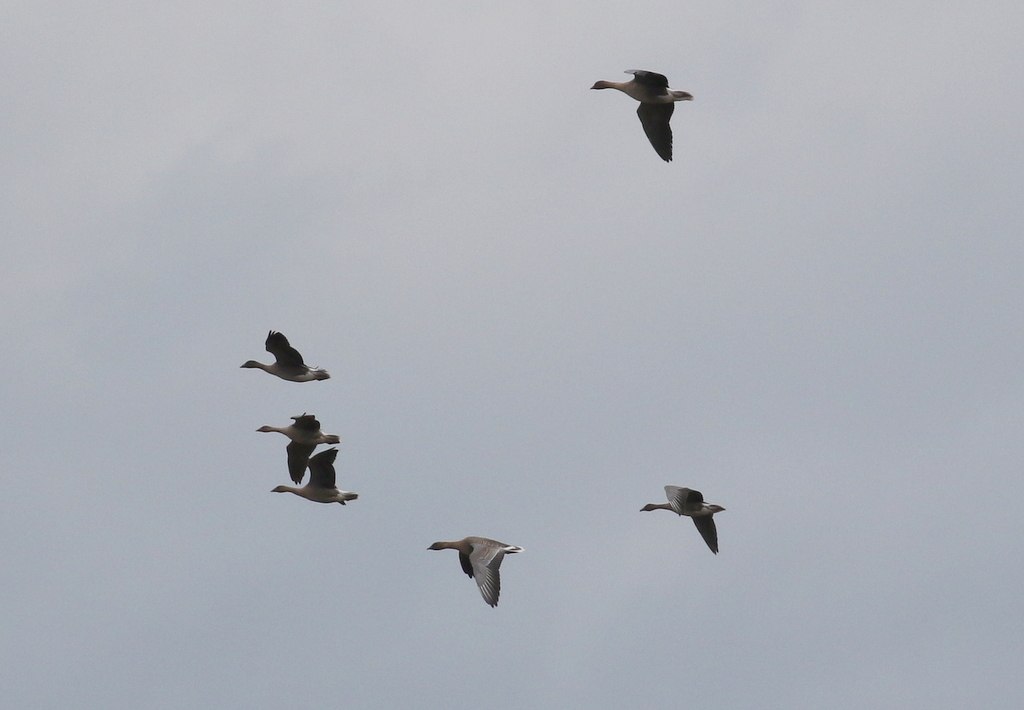 Pink-footed Geese – six, probably just arriving from Iceland for the winter
Pink-footed Geese – six, probably just arriving from Iceland for the winter
The new shelter overlooking Arnold’s gave us somewhere welcome to get out of the wind. There were quite a lot of waders out on the water and we settled in to work our way through them. They were mostly Black-tailed Godwits and Redshank, along with a few Curlew. Looking carefully through the godwits, we found a couple which were more strongly marked on the back, browner, streaked with black, two Bar-tailed Godwits.
On our first scan, their were just a couple of Dunlin but as we looked back we came across another group of four. A slightly larger wader was with them and through the scope we could see it was a Curlew Sandpiper, a juvenile. We could see the peachy wash across its breast and unstreaked white belly. Its bill was a little longer than the Dunlins’ and cleanly downcurved, rather like a miniature Curlew (hence its name!).
We had seen a large mob of Sandwich Terns out over the sea beyond the shingle bank and they started to fly in and land on one of the smaller islands. We got them in the scope and had a good look at them, noting their black bills with small yellow tips. They were in winter plumage now, with white crowns and the black on their heads now restricted to a line running back from the eye to the shaggy crest at the back.
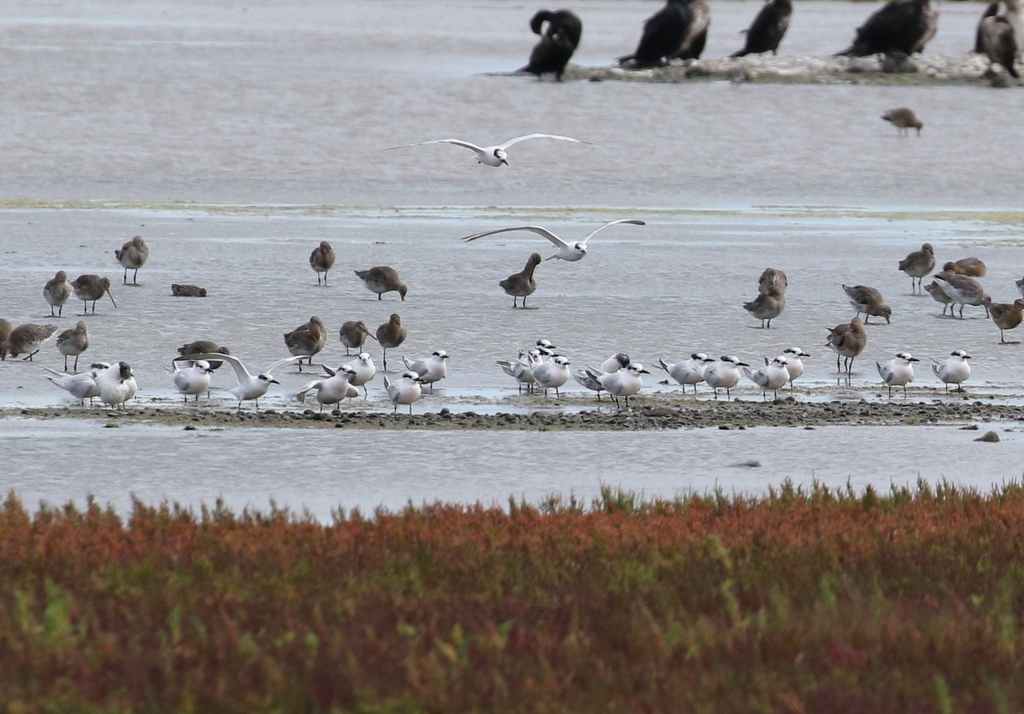 Sandwich Terns – came in to land on one of the islands
Sandwich Terns – came in to land on one of the islands
At that point, someone came into the shelter and informed us that the Pectoral Sandpiper had reappeared, back at the south end of the Serpentine. Thankfully it didn’t take us long to locate it, when it ran out along the edge of a muddy pool, before disappearing back into the grass. Thankfully, with a bit of patience, it showed very well and we had several very good looks at it through the scope. It kept going into the long grass out of view but after a while it would come out onto the edge again. We could see its distinctive streaked breast, cleanly demarcated from the white belly.
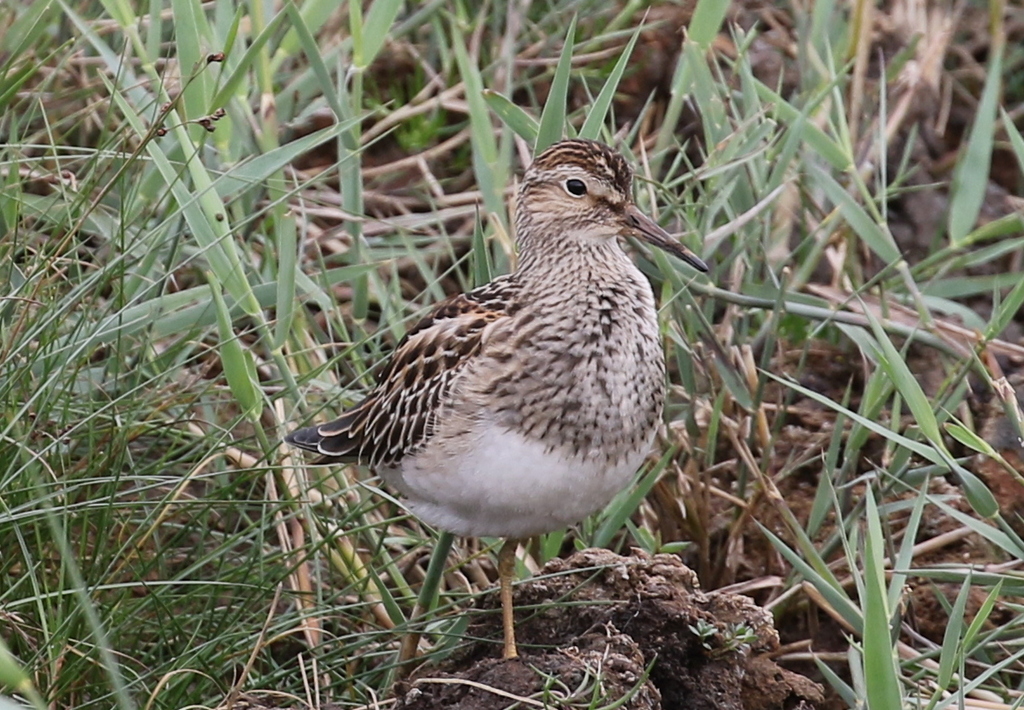 Pectoral Sandpiper – this photo of it taken a couple of days ago!
Pectoral Sandpiper – this photo of it taken a couple of days ago!
The Pectoral Sandpiper gradually worked its way a little closer towards us along the edge of the pool. Suddenly it stopped on the mud and stood up tall, then took off and flew across the water, landing down on the front edge behind the grass where we couldn’t see it. We had already had a great view, so we decided to head back to the visitor centre for lunch. It was a relief to get off the East Bank and out of the wind!
After lunch, we decided to have a quick look out on the reserve. There is management work underway at the moment on Whitwell Scrape, with a large excavator digging it out. This is causing a lot of disturbance to the other main scrapes, but we thought it worth a quick look just in case something had dropped down on here. On the walk out, we could see a Marsh Harrier quartering the reedbed, this one a dark chocolate brown juvenile.
There didn’t seem to be much on Simmond’s Scrape when we looked out from the hide. Scanning carefully, we did find a couple of Ringed Plover out on one of the islands, with a single Dunlin. A Ruff was over the far side, picking its way along the edge. A couple of Shoveler were feeding down in front of the hide, barely raising their heads out of the water.
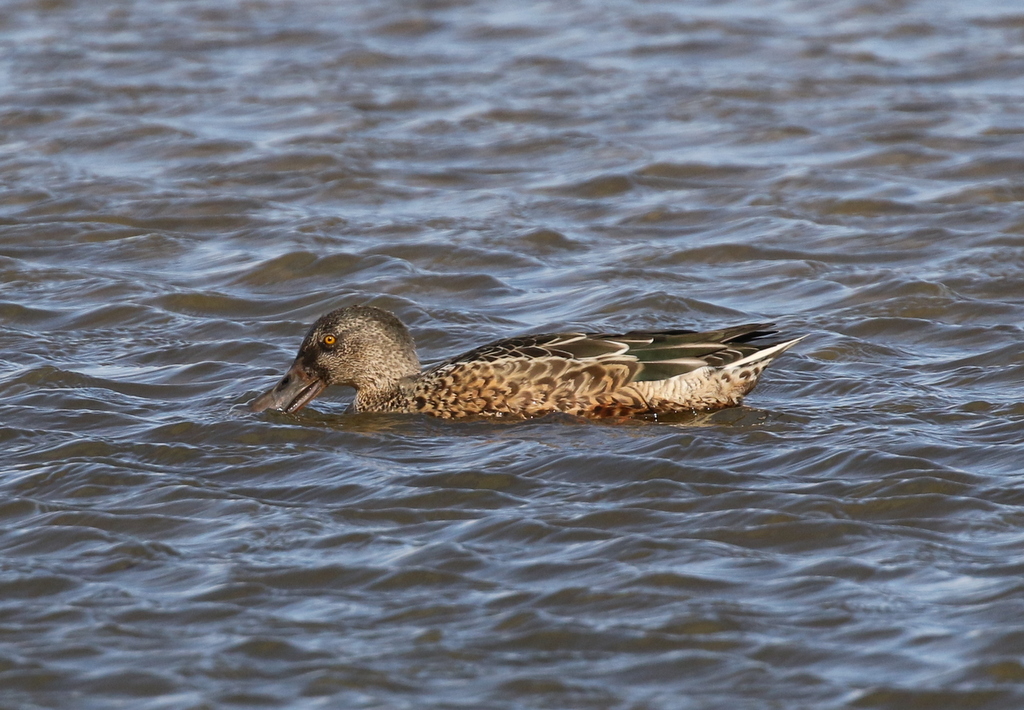 Shoveler – almost raising its head out of the water
Shoveler – almost raising its head out of the water
A Little Egret flew in and started feeding along the near edge of the scrape. A family of Mute Swans were in the channel in front of the hide. The Pied Wagtails liberally scattered around the islands seemed to be the only ones completely unconcerned with all the machinery working nearby.
Another Marsh Harrier flew across over the reeds the other side of the scrape, a dark male we could just see some small patches of grey in the upperwing and the paler underwings with black wingtips. A little while later, another Marsh Harrier flew back the other way, from the direction of North Scrape – a different bird again, this one a female.
 Marsh Harrier – a dark male flying over the reeds behind Simmond’s Scrape
Marsh Harrier – a dark male flying over the reeds behind Simmond’s Scrape
There was not much on Pat’s Pool either, a few more Ruff, a handful of Black-tailed Godwits, some Lapwings and a few assorted gulls and ducks. We were just thinking about heading back to the visitor centre when we noticed a rather black cloud approaching behind the hide. The worst of the rain passed to the south of us, but we could hear rumbles of thunder as it did so. When it cleared through, we made our way back. A Common Whitethroat flicked ahead of us in and out of the brambles along the Skirts path.
It was already starting to ease, but we decided to finish the day with a visit to Kelling, hoping to get out of the wind. As we set off along the lane, a few Chaffinches and Greenfinches flew up into the dense blackthorn hedge from the stream. We could hear a couple of Chiffchaffs calling and a little further along one perched out briefly on the sunny edge of the hedge. There were a few more butterflies out in the sunnier more sheltered spots. The stubble field half way down was full of Red-legged Partridges and Pheasants, released ready for the shooting season.
We made our way down to the Water Meadow. At first the pool looked rather quiet, but the more carefully we looked, the more we found. By the end we had counted at least three Redshanks and five Ruff around the reedy edges. When we got down to the cross track and looked back at the muddy margin on the near side, we could see a Green Sandpiper over in the far corner. A couple of Dunlin down in the near corner caught our eye, just as a Common Snipe sneaked out of cover and walked across the mud, before disappearing back into the grass.
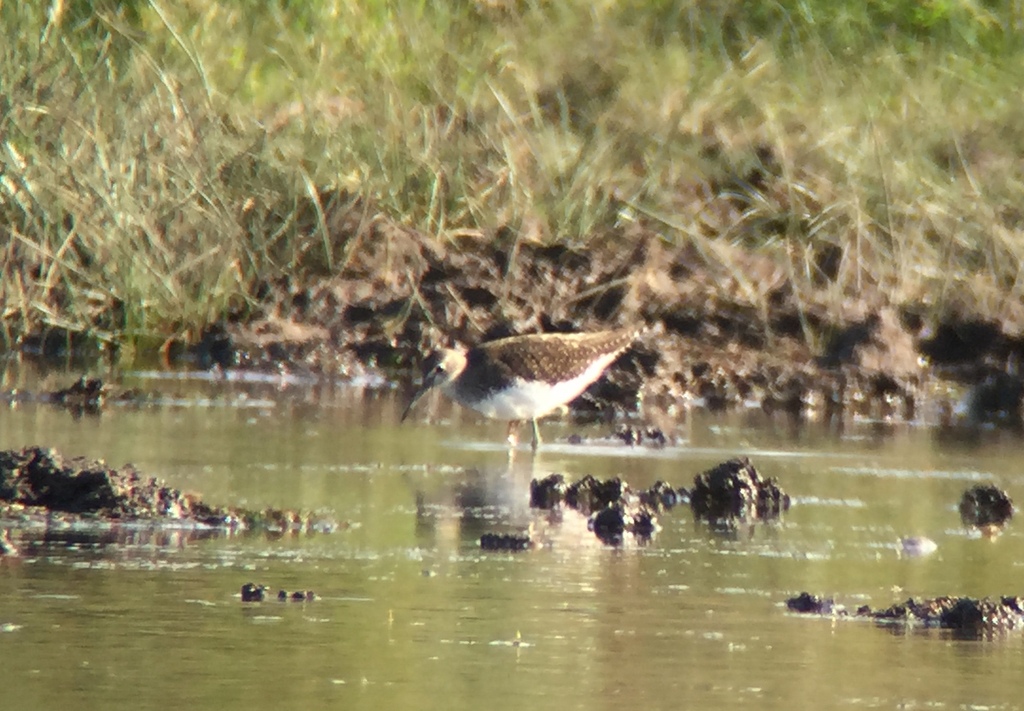 Green Sandpiper – on the back of the pool at Kelling WM
Green Sandpiper – on the back of the pool at Kelling WM
Continuing on along the path down towards the beach, it was fairly quiet at first, a Cetti’s Warbler calling from the reeds being the only bird of note. When we got to the corner and turned onto the path up the hill, we saw movement around the fence. A male Stonechat appeared and perched on the top strand of wire, and a Common Whitethroat appeared on the wire below. Turning to look back across the Quags, a careful scan produced a single Wheatear out on the short grass in the middle.
From half way up the hill, we turned to scan the sea. There were quite a few Sandwich Terns flying back west just offshore. An Arctic Skua appeared, flying low over the sea just behind them. We noticed a Great Crested Grebe swimming out on the water and as we watched it, a drake Eider took off from the sea just behind it and flew past us. We got the Great Crested Grebe in the scope, but after a minute it took off and flew off west too.
After that little flurry of activity, the sea went a little quiet. We were out of time anyway, so we turned and started to make our way back. The wind had dropped now and the sun was out, with blue skies overhead as we got back to the car. The wind had not stopped us today and we had enjoyed a very successful day out despite its best efforts. It had been a productive two days out, with a very good variety of birds seen.
















